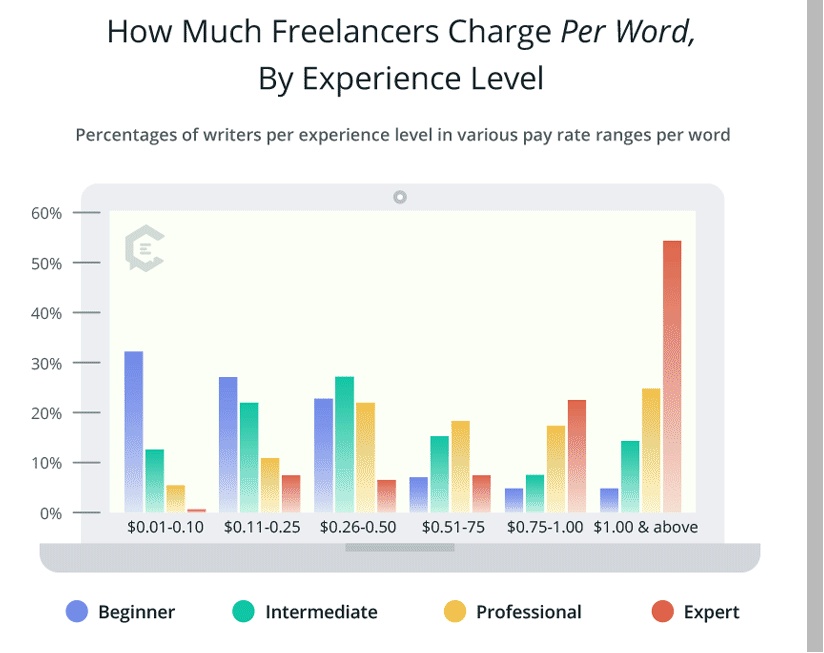Trying to figure out what to charge your freelance writing clients?
I’ve been there myself.
It can be confusing trying to decide on an hourly, per-word, or per-project amount.
Your freelance writing rate also depends on several different factors like your experience and portfolio.
Charge too little, and you won’t be able to making a real living. Charge too much, and you will scare away certain leads.
Ahead you’re going to learn how much to charge for freelance writing for various types of projects.
Freelance blog post rates
According to the Professional Writers Association of Canada, ghostwritten articles should be charged by 2-3x the normal amount.
I personally charge $0.25/word for blog posts with my current skill level and portfolio.
The problem is with articles is that they are far from the point of sale and often underappreciated. Some clients don’t understand that a good article can be generating serious traffic, leads, and revenue when done correctly.
But, there’s so many writing mills and websites to outsource crappy articles that its made productized and undervalued.
I would suggest charging no less than $0.10/word, even if you’re a beginner. It’s not uncommon for serious clients to pay upwards to $1/word for high quality long form pieces.
Clearvoice found that writers offer the following rates per word given their level of expertise.

Freelance copywriter rates
Copywriting is where the real money is at in freelance writing. Some experts get paid tens of thousands of dollars for a single landing page or sales letter.
And it’s all about ROI. If a client pays you $10,000 and generates $100,000 from your copy, everyone wins.
Charging higher rates for excellent copywriting is standard because it’s responsible for direct sales, leads, and other KPI’s.
I’m going to reference the Writers Association once again. They say that advertising material should be charged at:
- $350 to $500 per page
- $750 to $1,000 per project for brochures
- $75 to $150 per hour
And advertorials should include rates similar to the following:
- $0.40 to $2 per word
- $100 to $3,000 per article
- $40 to $100 per hour
Do you write newsletters for your clients? Then use these rates as a good benchmark:
- $0.30 to $1.50 per word
- $400 to $6,000 per issue
- $50 to $80 per hour
Web pages are a bit different. They don’t typically relate to direct sales, but rather help with branding, positioning, and displaying a unique value proposition.
If you’re an out-of-the-box thinker and creative, this could be a good avenue for you. I normally charge $2,000 for a 5 page website.
Freelance copyediting rates
According to the Professional Writers Association of Canada, the standard freelance editing rates are $30 to $60/hour or $500 to $20,000 per project.
Since you aren’t writing the content from scratch, it is typically less profitable, but still has decent earning potential.
Many writers, even myself immediately, mess up with grammar and other technical parts of writing.
Being a good editor is a very valuable skill and can easily land you plenty of gigs or clients.
Freelance proofreading rates
The Editorial Freelancers Association publishes industry standard rates, and proofreading is believed to be in the $30 to $35/hour range.
While it’s very similar to copyediting, proofreaders are typically looking for minor mistakes and confirm when it’s ready to be published. They would come in after an editor has made final changes to polish it up.
How to decide on a freelance writing rate
Even with the above information as references, creating your own price can be tough.
I’ve been writing for 6+ years and this is what I’ve concluded plays into the pricing.
Your portfolio
How big is your portfolio? Do you have very impressive pieces from big publications like Huffington Post or industry specific magazines?
The bigger and more respectable your portfolio becomes, the more you can charge.
Big brands aren’t going to work with just any writer. Name dropping isn’t an ego thing, it shows that publications with high standards trust you and your work was good enough to be used.
Gradually increase your rate by a few cents per word when you gain big portfolio pieces. If you charge hourly, you could do a $10 increase for example — whatever you find is reasonable.
How long you’ve been writing
Imagine you’re a business owner. You’re looking for a new content writer. You’ve found two great candidates, but there’s one big difference between them.
One has been writing for 1 years. The other for 5 years.
Who do you think you’d choose if everything else was equal? More than likely the second person.
The time you’ve spent as a writer has a big influence on your rates.
This gives you experience writing different material, in various tones, and for varying audiences. Your skill set will be wider or more defined — i.e if you spent all of those years only mastering copywriting.
As a result, I suggest raising your freelance writing rates the more time you spend as a writer.
The scope of work
I believe in being flexible as a freelance writer. You shouldn’t be too strict about your rates in some cases.
For example, if an article can be written with little to no research, it makes sense to charge less if your client doesn’t have a bigger budget.
But, if the project required extensive research and planning, it’s fair to charge more as you’ll need to put much more work in.
Per word vs per hour vs per project
It’s been long debated which pricing model is best. I personally believe that per word and per project is ideal.
Basing your freelane writing on an hourly rate requires you to keep track of the exact time it takes to complete a project and dividing it accordingly.
You also run into the situation where clients will want to see proof that you worked a certain amount of hours.
For blog posts and simpler work, per word is usually best. This is especially true when there isn’t a very specific word count — this way you’re paid for exactly how much effort you put in.
Bigger copywriting and ghostwriting projects are the most suitable for per-project based pricing. Think landing pages, sales letters, books, and advertising campaigns.


![How to Be a Freelance Writer and Get Rich While Doing it [Ultimate Guide]](https://thecopywritingfox.com/wp-content/uploads/2018/10/Featured-image-500x383.jpeg)